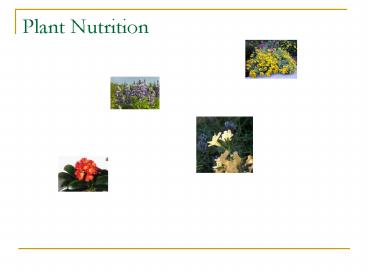Plant Nutrition - PowerPoint PPT Presentation
1 / 12
Title:
Plant Nutrition
Description:
... are those elements essential for plant growth which are needed in only very ... Nitrogen- the greatest limiting factor to plant growth. Soil Bacteria and nitrogen. ... – PowerPoint PPT presentation
Number of Views:173
Avg rating:3.0/5.0
Title: Plant Nutrition
1
Plant Nutrition
2
Macronutrients
- Macronutrients can be broken into two more
groups primary and secondary nutrients.
The primary nutrients are nitrogen (N),
phosphorus (P), and potassium (K). These major
nutrients usually are lacking from the soil first
because plants use large amounts for their growth
and survival. - The secondary nutrients are calcium (Ca),
magnesium (Mg), and sulfur (S). There are usually
enough of these nutrients in the soil so
fertilization is not always needed. Also, large
amounts of Calcium and Magnesium are added when
lime is applied to acidic soils. Sulfur is
usually found in sufficient amounts from the slow
decomposition of soil organic matter, an
important reason for not throwing out grass
clippings and leaves.
3
Micronutrients
- Micronutrients are those elements essential for
plant growth which are needed in only very small
(micro) quantities . The micronutrients are boron
(B), copper (Cu), iron (Fe), chloride (Cl),
manganese (Mn), molybdenum (Mo) and zinc (Zn).
Recycling organic matter such as grass clippings
and tree leaves is an excellent way of providing
micronutrients (as well as macronutrients) to
growing plants.
4
Soil Quality
- Topsoil the result of erosion and
decomposition. - Loams-the most fertile soils. Provide both
nutrients and air spaces. - Contains essential nutrients and a vast number of
living organisms. The living organisms aerate
and provide decomposing organisms to return
nutrients to the soil.
5
Clay and Ion Exchange
- Clay is negatively charged. This negative
charges allows water molecules to stick. This
water is a solution of minerals in the form of
ions for the roots to absorb. - Negatively charged ions dont bind t the clay and
are therefore easily picked up by the roots. - Positively charged ions such as potassium and
calcium are bound tightly to the clay and are
picked up by ion exchange. The root exchanges
hydrogen ions for the minerals.
6
Soil Conservation
- Sustainable agriculture is centered around
sustaining the top soil. Disasters such as the
Dust bowl have occurred because there was no soil
conservation. - Fertilizers- adds essential minerals back to
soil. Must be done in a way that preserves soil
pH and doesnt pollute ground water. - Irrigation- must be done in a way that provides
water with out destroying the water sources or
altering the salinity of the soil. - Erosion- over farming removes the plant roots
from the soil that help hold the top soil in.
Dry windy conditions cause the top soil to erode.
Planting patterns such as adding trees to the
perimeter of farmed land can help prevent
erosion. - Soil reclamation- rehabilitation soil.
Phytoremediaiton uses plans that are able to
extract pollutants from the soil.
7
(No Transcript)
8
Nitrogen- the greatest limiting factor to plant
growth.
- Soil Bacteria and nitrogen. Plants cant take
nitrogen from the air. Nitrogen is made
available through bacteria in the soil. - Decomposition releases ammonia into the soil
- Nitrogen fixing bacteria takes N2 and turns it
into NH3(ammonia) which will then from
NH4(ammonium ion). Plants can pick up ammonium. - Most nitrogen is taken up in the form of NO3-
(nitrate) Ammonium is converted to nitrate by
nitrifying bacteria.
9
(No Transcript)
10
Symbiosis and Bacteria
- Nitrogen fixation occurs in root nodules
containing nitrogen fixing bacteria in the legume
family. The bacteria provides the plant with
nitrogen and the plant provides carbohydrates to
the bacteria.
11
Symbiosis and Fungus
- Mycorrhizae- fungus on the roots that have a
mutualistic relationship with plants. The fungus
increases surface area for the root, secrete
growth factors, and protect the plant from
pathogenetic bacteria. In return the plant
provides carbohydrates to the fungus.
12
Nutritional Adaptations of Plants
- Epiphytes- grows on another plant. Usually
absorb water and minerals through leaves rather
than roots. Growing anchored on a tree gives
greater access to sunlight. - Parasitic Plants- absorb sugars and minerals from
roots that enter the host plant - Carnivorous plants- live in soils that lack
nitrogen. Use modified leaves to trap and digest
insects.































